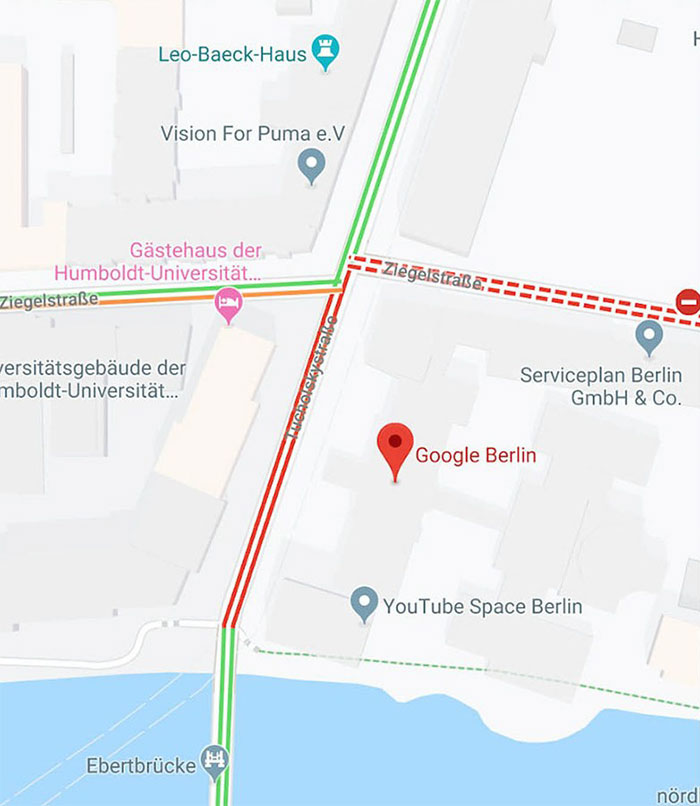One day in Berlin, Google Maps showed the red line denoting bumper-to-bumper traffic on several ordinarily calm streets, even though there was no special event taking place. Or anything happening on those streets, actually. The culprit: one man slowly walking around the city pulling a red wagon.
Berlin artist Simon Weckert rented 99 Android smartphones, installed 99 sim cards in them and filled a wagon with them, all powered on and running Google Maps. He then took to the streets of Berlin with them at a time when traffic was sparse. The object of the experiment, which he conducted last summer, but just published yesterday for the 15th anniversary of Google Maps, was to show how much we rely on the app’s traffic technology despite its limitations. It also answers some questions we’ve probably all had about how Google Maps actually works.
Artist Simon Weckert walked around Berlin with 99 phones in a wagon
Image credits: Simon Weckert
Image credits: Simon Weckert
Image credits: Simon Weckert
Image credits: Simon Weckert
The way Google Maps estimates traffic is by assessing the density of phones that enable the app to access their location, confirmed a Google spokesperson. Therefore, to the app’s technology, the only explanation for Weckert’s 99 phones in a condensed space was a dense traffic jam. The spokesperson also said, somewhat creepily, that Weckert’s experiment helps Google figure out where its geolocation needs to improve. It can distinguish between the motions of a car and a motorcycle, apparently, but recognizing movement in a wagon is still beyond it.
Image credits: Simon Weckert
Image credits: Simon Weckert
Image credits: Simon Weckert
Image credits: Simon Weckert
Image credits: Simon Weckert
Image credits: Simon Weckert
Image credits: Simon Weckert
Image credits: Simon Weckert
If you’re wondering why a bus full of people with smartphones doesn’t automatically show up as a traffic jam, a bus is very easy to recognize via geolocation, as such a cluster of users follows a predictable path and stops in predictable places. Maybe Weckert’s next experiment should be trying to fool Google Maps into thinking he’s a bus.
A video of the experiment shows how quiet the streets actually were during the “traffic jam”
Image credits: Simon Weckert
The question on everyone’s minds is why? Weckert wanted to show how we rely on data to predict reality for us so we can plan our actions around it, trusting it as an objective display of reality, even though the technology used to interpret data can err or be misled, potentially forming an inaccurate model. Commenters are already coming up with ideas for gaming the system based on his experiment, while others think it worked a little too well and could have dangerous consequences.
Not everyone sees the value of the experiment, but it gave some people ideas
I did not know google estimates traffic by assessing number of phones being used
That's how they can say how long people usually stay at a certain place like a restaurant or when it's the best time to go there.
Load More Replies...I find this very amusing. This guy is proving that Google now is so powerfull that it can control traffic flows in any given city. Yes, the friendly search engine has turned into your worst nightmare and a lot of people keep supporting it. I also think that it's hilarious that BP is blurring his face, while the artist doesn't hide his name nor where he is and he's clearly recognisable in the video.
I did not know google estimates traffic by assessing number of phones being used
That's how they can say how long people usually stay at a certain place like a restaurant or when it's the best time to go there.
Load More Replies...I find this very amusing. This guy is proving that Google now is so powerfull that it can control traffic flows in any given city. Yes, the friendly search engine has turned into your worst nightmare and a lot of people keep supporting it. I also think that it's hilarious that BP is blurring his face, while the artist doesn't hide his name nor where he is and he's clearly recognisable in the video.

 Dark Mode
Dark Mode 

 No fees, cancel anytime
No fees, cancel anytime 







































































150
47